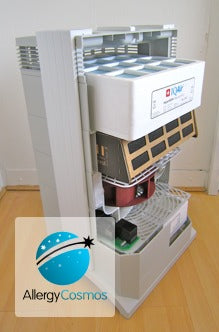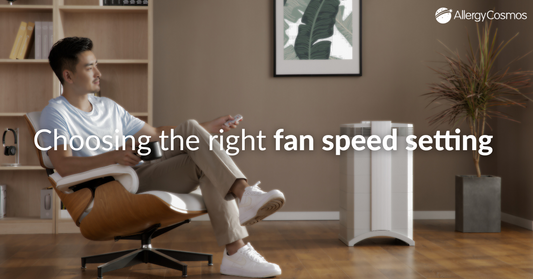There are so many different kinds of air purifiers and air cleaners on the market, that it’s hard to know which one is the right one for you. Let’s start by asking: How does an air purifier work, and how they can help you? In other words, what’s in the box, and what will it do? Different air cleaners have different strengths - but let’s assume our primary concern is general particle pollution (that will include dust mite allergens, pet dander, mould, bacteria, parts of traffic pollution and more).
HEPA Air Purifiers
The US Environmental Protection Agency recommends HEPA air purifiers (High-Efficiency Particulate Air), saying they are the most effective air cleaners. So how does a HEPA air purifier work? HEPA filters consist of a folded mat of fibres and have three different modes of action, each of which acts upon a different size of the particle. Interception deals with particles above 0.4 microns in diameter and involves the particle sticking to a fibre in the HEPA filter when it comes close to it. In Impaction, the particle is blown towards the fibres by the airstream on which it is travelling, collides and sticks to it. Then there is Diffusion, which mainly affects smaller particles, of diameter below 0.1 microns. The particle collides with air molecules which throw it off course.
Diffusion keeps the particle within the filter until it is captured by impaction or interception. What about particles between this size range? They are captured, but with a very small decrease in efficiency. In fact, the ability of a HEPA filter to capture particles of size 0.3 microns is actually used as a measure of its effectiveness. The DOP penetration test involves sending a test stream of particles of this size through the filter and using a particle counter to measure the particles in the in going stream and outgoing stream to see what proportion is removed by the filter. A leakage free HEPA air purifier will remove 100% of house dust mite allergen in the air. To learn more please visit our HEPA Air Purifier Information page.
Electronic Air Purifiers
How does an air purifier work that uses electronic filtration? 'Electronic' air purifiers work by giving the particles of pollution that pass through the unit an electric charge and then using electrostatic attraction (positive attracts negative and vice versa) to trap the particles. There are different kinds of electronic air purifiers - two popular versions are Electrostatic Precipitators and Ionisers. The Electrostatic Precipitator sucks air into the unit, charges up the particles in the first section and then passes the stream to a pair of plates bearing an opposite charge so that the particles stick on to the plates. A mere Ionizer acts externally rather than internally in that it releases ions into the environment. This charges up the particles in the air and they become attracted to their surroundings by electrostatic attraction (ever tried rubbing a balloon on your jumper and making it stick to the wall, or curtains? You’ve got the idea!). A problem here is that electrically charged pollution can be an inconvenience when it sticks to walls, furnishing and other objects in your house. For that reason, we do not recommend air purifiers that use mere ionization and do not combine it with a mesh filter (sometimes called HEPA-like) filter. Another concern is that the ionization process can emit ozone, which is a pollutant and lung irritant in its own right.
UV Air Purifier
Ultra-Violet (UV) light is very short wavelength radiation that kills living particles like viruses, bacteria, and moulds (generally known as microorganisms) if they are exposed to the light for a significant amount of time. The performance in terms of killing microorganisms with a UV light depends upon the dose of UV light the air pollution is exposed to, the actual length of time the microorganisms are exposed to the light, and the nature of the microorganism involved (not all bacterias are killed by UV, nor are mould spores). In general, microorganisms have to be exposed to UV light for several hours to be killed. Given that the air passes through an air purifier within a fraction of a second, UV light is not an effective way to eliminate microorganisms from the air.
Gas / Chemical Air Purifier
What if you’re concerned about Volatile Organic Compounds (VOCs) rather than house dust mite allergen or other particles? These are gaseous molecules, rather than particles, and none of the above air purifier types by themselves will remove them. VOCs, like other chemicals, are removed by purifiers containing activated granular carbon, or equivalent, filters. Important here is the quality of the carbon that is being used. Carbon dust (which is relatively cheap) will not be effective. Some air purifiers, like the IQAir HealthPro 250, combine a HEPA filter with a powerful gas filter, thereby removing the widest range of pollutants.




